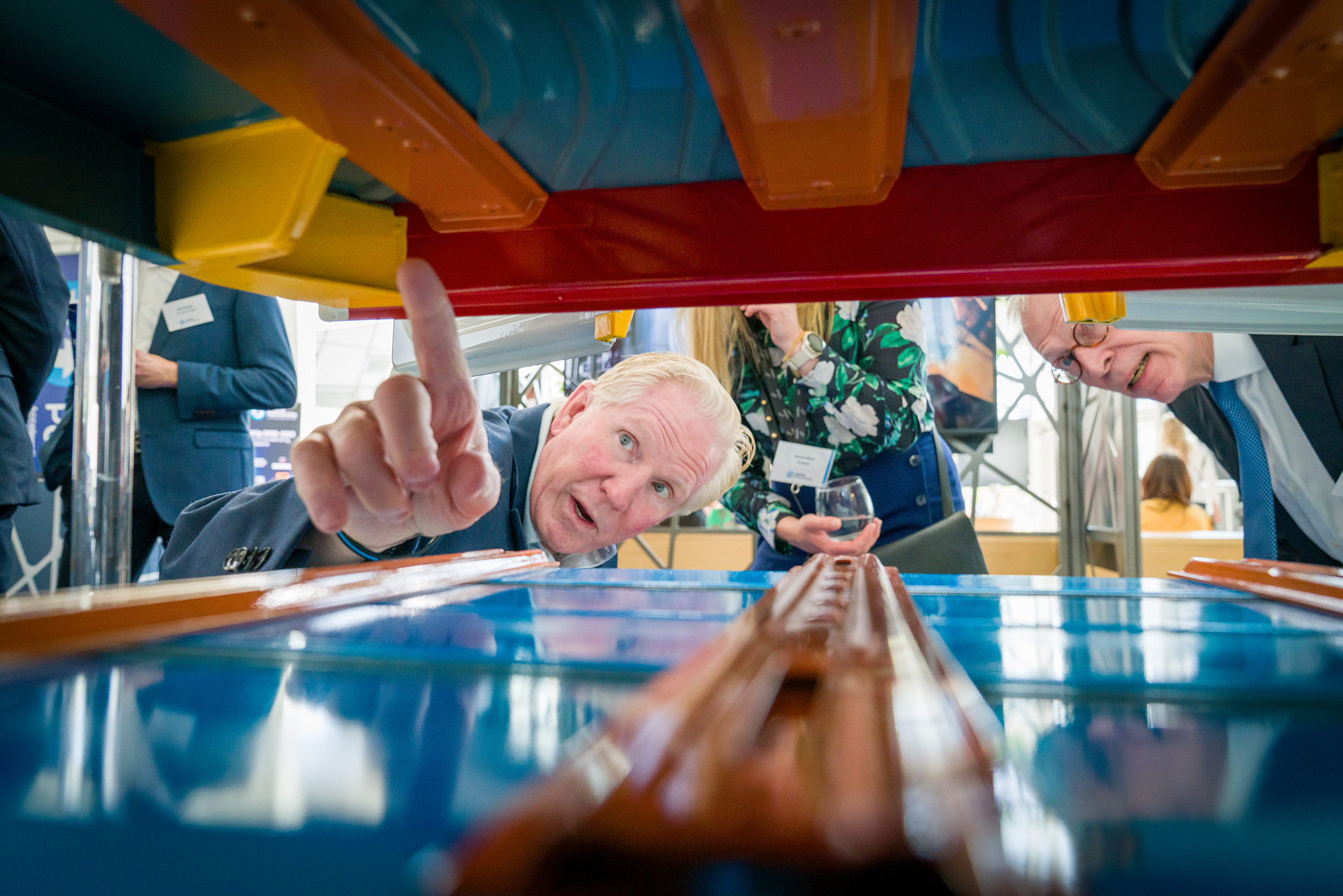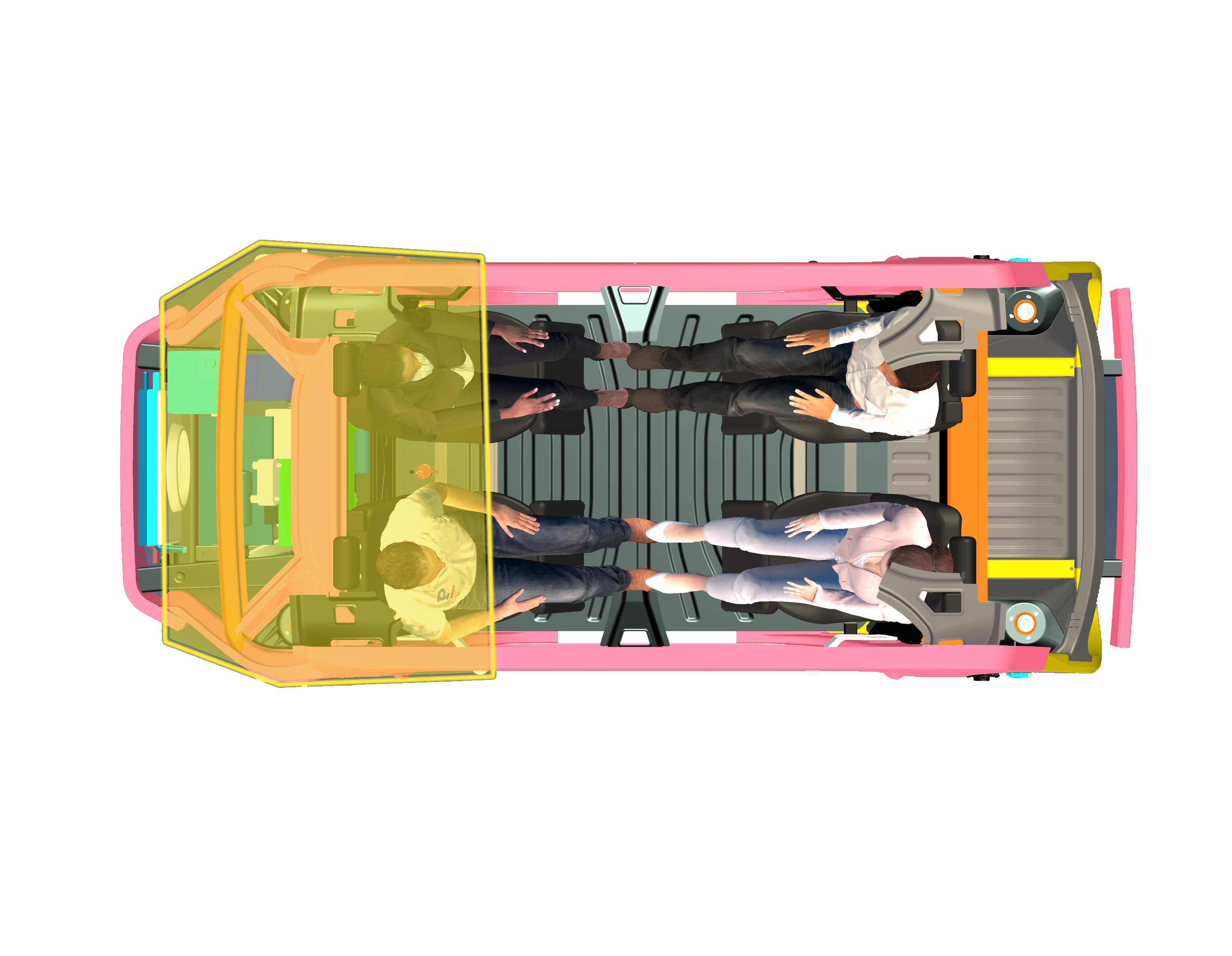Steel: a sustainable solution for future mobility

George Coates, Technical Director at WorldAutoSteel (left) and Cees ten Broek, Director at WorldAutoSteel (right) looking under the Steel E-Motive scale body structure.
For decades, steel has been the traditional material of choice for automotive applications, and it now can be the sustainable option for future mobility. This is best demonstrated by WorldAutoSteel’s Steel E-Motive programme, which has developed one of the world’s first fully autonomous, battery electric vehicle body structure concepts for ride sharing, that fully comply with global high-speed crash standards.
Steel E-Motive is the culmination of a three-year research programme led by WorldAutoSteel in partnership with global engineering firm Ricardo. Since programme results were highlighted in August, there has been considerable interest in its transformative sustainability capability, especially its potential to reduce total lifecycle greenhouse gas (GHG) emissions by up to 86%.
The figure is based on a comparison with a reference 2022 battery electric vehicle (BEV) and an expected production date for Steel E-Motive of between 2030-35. It was ascertained through life cycle analysis (LCA) carried out by Ricardo’s LCA experts. The focus of the analysis was on GHG emissions and total energy consumption from the vehicle manufacture and assembly, vehicle use and end of life/recycling phases. Full details on the analysis can be found in the Steel E-Motive Engineering Report, which can be downloaded freely at www.steelemotive.world.
Steel E-Motive takes advantage of the fact that Advanced High Strength Steel (AHSS) is the only automotive material that can have a reduced environmental impact in all three key phases of the vehicle life cycle: manufacture, use and end-of-life.
Manufacturing safe, efficient and economical vehicle architectures
The design of the vehicle using Advanced High-Strength Steel (AHSS) brings several sustainability benefits. Steel E-Motive can be produced using existing global manufacturing and supply resources, which eliminates the need to build new plants and machinery to produce them. Steel E-Motive’s design and engineering focuses heavily on minimising material thickness, reducing the amount of material it requires, and maximising material utilisation through efficient manufacturing processes that reduce scrap. Steel E-Motive’s use of an AHSS body structure, purpose-made for electric vehicles, achieves a 27% mass reduction in the body structure – from an expected steel reference vehicle of 374 kg to 282 kg, a mass that is competitive with multi-material vehicles. This not only means fewer emissions in use, due to the vehicle being lighter, but less material production and emissions in the first place. Further weight savings come from intelligent battery packaging that is 37% lighter than average reference battery pack structures at 27% less cost. AHSS also assures safety: Steel E-Motive’s design is engineered to meet global high-speed crash regulations that can achieve the IIHS ‘Good’ rating. In all, Steel E-Motive has seven Advanced High-Strength Steel structural innovations that provide safe, efficient and economical vehicle architectures. (Editors’ Note for full list.)
Already-efficient steel moving to decarbonisation
The automotive industry is increasingly focusing on the manufacturing stage of its materials to drive down the overall lifetime emissions of their vehicles. Steel already scores well in its primary production: alternative materials have emissions that are between six and 17 times higher at this stage. Steelmaking, already a highly efficient industry, is moving as swiftly as it can towards decarbonisation, with many efforts underway. One example is the use of techniques such as Direct Reduced Iron (DRI), which utilises hydrogen as the reducing agent instead of coal-based coke to chemically reduce the iron ore to metallic iron. Combining a DRI process using ‘green’ hydrogen (produced by water electrolysis powered by renewable electricity), with electric arc furnace (EAF) steel production which utilises higher percentages of recycled steel, provides the best overall potential for decarbonised steel production, according to Steel E-Motive’s Engineering Report. Currently a small number of DRI pilot production facilities are in operation, with many larger scale plants under construction or planned to be operational within Steel E-Motive’s envisaged timeframe. By 2035, a significant proportion of the steel in a vehicle’s construction is expected to be manufactured using decarbonised production methods.

The AHSS Extended Passenger Protection Zone provides excellent cabin intrusion protection and ultimately a lower risk of injury. PHS provides formability for challenging geometries, which Martensitic steel (MS) provides the strength to limit intrusion.
Gains from green electricity and drive cycle smoothing
Emissions from the generation of the energy expended during a vehicle’s use phase is an important consideration, and Ricardo modelled several different scenarios for these energy impacts for Steel E-Motive’s LCA. Ricardo used the International Energy Agency (IEA) World Energy Outlook (WEO)’s predictions on differing electricity sources and projected future trends in its LCA calculations. The greening of the electricity grid will account for the single most important change and the highest reduction in emissions.
While green electricity is a key factor, autonomous vehicles also contribute other emissions reduction potential. One important element is known as drive cycle smoothing. The vehicles’ advanced gathering of data enables them to optimise acceleration and deceleration, for example predicting traffic signals and adjusting speed accordingly. This means they use less energy to cover the same distance – with a predicted reduction in energy consumption of around 15%.
Steel E-Motive is designed for Mobility as Service (MaaS), where one of the key advantages is to increase passenger occupancy rates, meaning fewer vehicles will be required to transport the same or a greater number of people. Steel E-Motive’s urban concept version accommodates up to four passengers per vehicle; an inter-city version accommodates as many as seven passengers. Autonomy also helps: with no driver, there is more room for passengers. High-strength steel, coupled with design efficiency, also means that the interior can be maximised relative to the vehicle’s footprint, giving interior designers the greatest scope to make it as inviting as possible for people to share rides. This can significantly reduce the CO2 per passenger-kilometre.
“Consumers must feel comfortable enough to use this transport, with maximum capacity regularly achieved, in order to make the greatest impact towards total emissions reduction,” notes Russ Balzer, WorldAutoSteel Technical Director, LCA. “That is why a highly crashworthy, spacious and open vehicle cabin, as Steel E-Motive demonstrates, is key towards attaining consumer confidence, and ultimately, Net Zero ambitions.”
MaaS will require vehicles to have a longer service life, at least twice the life of consumer-driven vehicles, which Steel E-Motive will make possible through AHSS’s fatigue and durability properties together with the vehicle design, which enables easy replacement of battery modules.
Infinitely recyclable steel offers unparalleled end-of-life advantages
What happens at the end of a vehicle’s life is also important within the life cycle. With an already established steel recycling infrastructure across the world, steel provides significant sustainability advantages. The envisaged greater use of EAF will drive up the use and demand for recycled steel, which is infinitely recyclable with no loss of quality.
Balzer concludes: “The Steel E-Motive concept demonstrates that steel is thoroughly fit for purpose in the future mobility landscape. Steel must play a part in the emissions-reduction discussion. Steel E-Motive shows what autonomous, steel-based, ride-sharing vehicles used within a green grid can do to significantly reduce CO2 emissions.”
Steel E-Motive concepts can be freely studied through the engineering report, adopted by start-ups for a quicker time to market and its many innovations applied to current and future electric vehicles. Computer-aided design reviews are available through WorldAutoSteel member companies (see steelemotive.world/meet-the-team for a member list).
Steel E-Motive is the latest in a series of steel industry demonstrations over the past 25 years that showcases new AHSS applications for automotive structures. WorldAutoSteel, which comprises 18 global steel producers, is the automotive group of the World Steel Association. WorldAutoSteel led the Steel E-Motive project, working closely with Ricardo, who managed the overall engineering design, testing, and development.
| |
|
